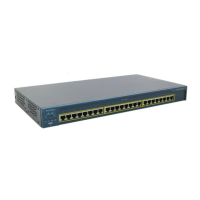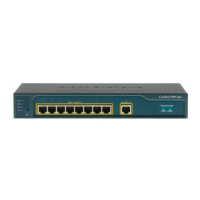27-12
Catalyst 2950 and Catalyst 2955 Switch Software Configuration Guide
78-11380-12
Chapter 27 Configuring SNMP
Configuring SNMP
You can use the snmp-server host global configuration command to a specific host to receive the
notification types listed in Table 27-4.
Beginning in privileged EXEC mode, follow these steps to configure the switch to send traps or informs
to a host:
cluster Generates a trap when the cluster configuration changes.
config Generates a trap for SNMP configuration changes.
copy-config Generates a trap for SNMP copy configuration changes.
entity Generates a trap for SNMP entity changes.
envmon Generates environmental monitor traps. You can enable any or all of these
environmental traps: fan, shutdown, status, supply, temperature.
flash Generates SNMP FLASH notifications.
hsrp Generates a trap for Hot Standby Router Protocol (HSRP) changes.
mac-notification Generates a trap for MAC address notifications.
port-security Generates SNMP port security traps. You can also set a maximum trap rate
per second. The range is from 0 to 1000; the default is 0, which means that
there is no rate limit.
rtr Generates a trap for the SNMP Response Time Reporter (RTR).
snmp Generates a trap for SNMP-type notifications.
stpx Generates SNMP STP Extended MIB traps.
syslog Generates SNMP syslog traps.
tty Generates a trap for TCP connections. This trap is enabled by default.
vlancreate Generates SNMP VLAN-created traps.
vlandelete Generates SNMP VLAN-deleted traps.
vlan-membership Generates a trap for SNMP VLAN membership changes.
vtp Generates a trap for VLAN Trunking Protocol (VTP) changes.
Table 27-4 Switch Notification Types (continued)
Notification Type
Keyword Description
Command Purpose
Step 1
configure terminal Enter global configuration mode.
Step 2
snmp-server engineID remote
ip-address engineid-string
Specify the engine ID for the remote host.
Step 3
snmp-server user username
groupname {remote host [udp-port
port]} {v1 [access access-list] | v2c
[access access-list] | v3 [encrypted]
[access access-list] [auth {md5 | sha}
auth-password]}
Configure an SNMP user to be associated with the remote host created in
Step 2.
Note You cannot configure a remote user for an address without first
configuring the engine ID for the remote host. Otherwise, you
receive an error message, and the command is not executed.

